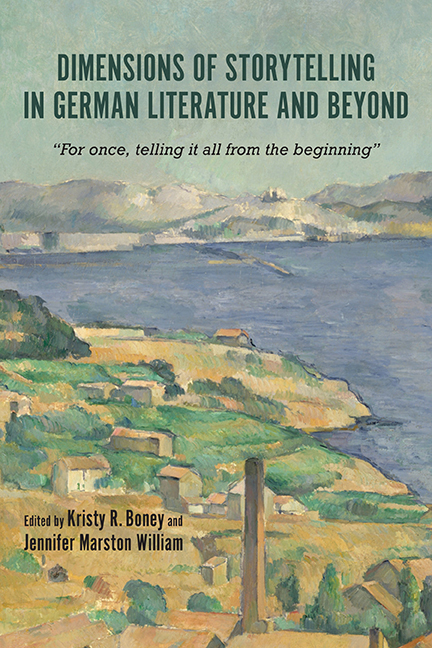 Dimensions of Storytelling in German Literature and Beyond
Dimensions of Storytelling in German Literature and Beyond Book contents
- Frontmatter
- Contents
- Acknowledgments
- Introduction: The Social, Political, and Personal Dimensions of Storytelling
- Part I Anna Seghers: A Missing Piece in the Canon of Modernist Storytellers
- 1 Anna Seghers in Heidelberg: The Formative Years
- 2 Who Is the Narrator? Anna Seghers's “The Excursion of the Dead Girls”: Narrative Mode and Cinematic Depiction
- 3 Anna Seghers's Rubble Literature, 1947–49
- 4 Anna Seghers and the Struggle to Tell Stories about the Nazi Past in the Early German Democratic Republic
- 5 Aufbauzeit or flaue Zeit? Anna Seghers's GDR Novels
- 6 The Time of Decision in Anna Seghers
- 7 Filling the Void with Stories: Anna Seghers's Conceptual Metaphors
- Part II Expressions of Modernity: Using Storytelling Unconventionally
- Part III The Personal Narrative: Storytelling in Acute Historical Moments
- Notes on the Contributors
- Index
3 - Anna Seghers's Rubble Literature, 1947–49
from Part I - Anna Seghers: A Missing Piece in the Canon of Modernist Storytellers
Published online by Cambridge University Press: 12 April 2019
- Frontmatter
- Contents
- Acknowledgments
- Introduction: The Social, Political, and Personal Dimensions of Storytelling
- Part I Anna Seghers: A Missing Piece in the Canon of Modernist Storytellers
- 1 Anna Seghers in Heidelberg: The Formative Years
- 2 Who Is the Narrator? Anna Seghers's “The Excursion of the Dead Girls”: Narrative Mode and Cinematic Depiction
- 3 Anna Seghers's Rubble Literature, 1947–49
- 4 Anna Seghers and the Struggle to Tell Stories about the Nazi Past in the Early German Democratic Republic
- 5 Aufbauzeit or flaue Zeit? Anna Seghers's GDR Novels
- 6 The Time of Decision in Anna Seghers
- 7 Filling the Void with Stories: Anna Seghers's Conceptual Metaphors
- Part II Expressions of Modernity: Using Storytelling Unconventionally
- Part III The Personal Narrative: Storytelling in Acute Historical Moments
- Notes on the Contributors
- Index
Summary
ON AUGUST 2, 1949, after Anna Seghers had been in postwar Berlin for about two years, she wrote to her American literary agent Maxim Lieber: “I have also noted very many things about both the land in which I live and other countries. Different specific situations and conversations in the last two years. The events of the last years prevent me from sending them to you.”
Why exactly was she so hesitant to publish these pieces? During her exile years Anna Seghers had already voiced specific ideas about how writers could help to “denazify” Germans. She wanted to take part in such an education project as early as 1942. In her essay “Volk und Schriftsteller” (The People and the Writer, 1942) she talks about her views that writers should live among their people, feel responsible for their country, and act upon their mandate to reeducate their audience after the fall of National Socialism. In her 1944 essay “Aufgaben der Kunst” (The Functions of Art) she goes a step further, speaking of the desired themes: “The artist of today must think of points of attack by which we can free the mentality of the fascist youth of monstrous delusion, of deceitful conceptions, of bossiness and mechanical obedience controlled by rigor-mortis-like uptightness.”
Such “Angriffspunkte” (points of attack) would be to write very realistically about the true postwar conditions of the individual, the people, and humanity (“Individuum,” “Volk,” “Menschheit”). The writer must bring to the conscience of her readers “the humiliation in which Germany fell, in order to make it still more terrible because of the realization of this humiliation, through the ruthless itemization of all that followed, all marks of political impotence, which not only mark the existence of the nation but also stigmatize the existence of every person in the nation, with countless, often only subconscious, effects” (197).
In addition to the depiction of post-fascist German reality in its actual shape, Seghers finds the themes of foreign peoples in their struggles for humanity to be an especially important topic for writers who have been in exile. Throughout the rest of her life she continued to develop her concept of writing about foreigners, their differences, and their struggles for autonomy and independence from colonial rule.
- Type
- Chapter
- Information
- Dimensions of Storytelling in German Literature and Beyond“For once, telling it all from the beginning”, pp. 43 - 54Publisher: Boydell & BrewerPrint publication year: 2018
